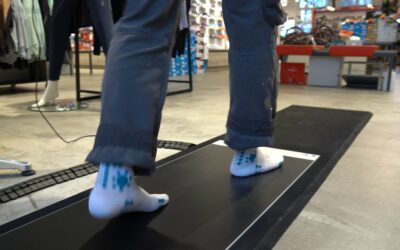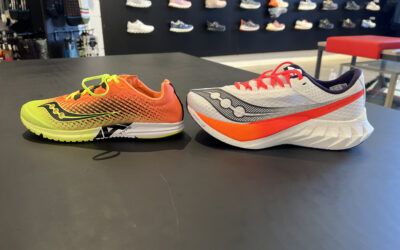Open water swimming becomes an issue for many early in the season, even for amateur swimmers who otherwise prefer to be in the pool. This is also confirmed by the many inquiries we receive in the store. That’s why we’re going to give you a little guide on how to swim in cold water.
Even though warm days are already behind us, the lakes need several weeks after winter to reach a stable temperature of over 10 degrees. We’re still talking about cold water swimming well into May. That’s why we’ve put together our most important tips for cold water swimming below.
Equipment
Crucial for your well-being in cold water is the equipment. We recommend wearing a long “proper” swim neoprene. Underneath the Neo, a special, flexible swimming thermal shirt can also keep you warm. It is very important to wear a neoprene swimming cap. Why a neo swimming cap? A lot of energy is released through the head. The head also cools down quickly. Cold water in the ears gives the body wrong signals and should be avoided as much as possible. The neo swimming cap is worth its weight in gold at water temperatures below 16 degrees. To protect the ears, earplugs have also proven to be very effective. There are neoprene gloves against cold hands. However, the swimming feeling suffers a bit. You have to decide for yourself whether you want to accept this small disadvantage in favor of warm hands. Finally, neoprene socks help against cold feet. When it comes to suits and socks/gloves, you have to make sure that they fit really tightly and leave as little (cold) water as possible between the insulation layer and the skin.
Training
Humans can get used to cold water. However, there is no way around exercising in cold water. If you swim regularly in cold water, you get used to it. If you are traveling alone, it is best to stay close to the shore, if possible even in shallow water. A safety buoy as well as an eye-catching swimming cap in light colours increase safety and are a must. The fact that it is possible to swim in cold water without damage and even for a longer period of time is ultimately also shown by the many SwimRun competitions in cool areas or triathlons in countries such as Norway, where people swim competitively even at water temperatures of 10 degrees.
Behaviour in the water
Every person who gets into cold water has to deal with different reactions of the body to this shock. Here is a short and simplified summary, which is mainly based on our experience: The first reaction is the same for everyone: Holding your face under water takes effort. This is natural and perfectly normal. The problem: In order to crawl, the face has to be brought under water. If you can’t do it right away, you should swim the first strokes in the water polo crawl (head stays above the water) and then keep your face under water every other stroke. After a few more turns, you should be able to crawl normally. This way you get used to the unpleasant feeling. Another common reflex concerns breathing: we tend to “gasp breathing” in cold water. Here it is very important to swim the first few meters LOOSELY and find the rhythm. Exhaling consciously helps enormously. As a rule, you get used to the conditions better and better after a few meters and can then continuously increase the pace.
Immediate preparation
There are several measures that can alleviate the cold water shock somewhat. A short warm-up program on land is highly recommended. It has proven to be a good idea to empty a good portion of water into the neoprene while still on land. From a scientific point of view, cold water would make more sense because the body can then already get used to the temperatures. It is more pleasant to pour warm water into the suit. Even if scientifically rather dubious, this method has proven itself in many cold water swims. What certainly helps, however, is wetting the face with cold water before swimming off. Above all, get into the water slowly and get used to the cold step by step.
Bless you
There isn’t a lot of research on the health risks of cold water swimming. Swimming in cold water is certainly a big challenge for the respiratory tract, especially at the beginning. In addition, the blood vessels tend to contract and thus increase blood pressure. In rare cases, this can lead to a cold shock. That’s why getting used to it slowly is so important. In principle, there is no need to fear damage to health. After all, the air we breathe in is not too cold, especially compared to winter (in cross-country skiing, competitions are allowed deep into the sub-zero range). Asthmatics may struggle with slightly more irritated airways. According to our experience, however, this is more likely to be attributed to the general influence of cold water on breathing and applies to all people. Probably the greatest health hazard is the cooling of the body. We start with this rule of thumb: number of degrees water temperature = possible time in the water without a suit (i.e. at 14 degrees = 14 minutes “survival time” only with swimming trunks). Modern swimming neoprene protects the body very efficiently from cooling down and, roughly speaking, can cause at least a doubling of this time (i.e. at 14 degrees = at least about half an hour of swimming time). The bottom line is that swimming in cold water is safe with the right equipment and preparation and is probably above all a matter of the mind.
Tempo Sport
Tempo-Sport has established itself in recent years as Switzerland’s leading triathlon specialist. But: With us, all non-triathlon enthusiasts – whether beginners or professionals – will also find a large selection and competent advice in the areas of swimming, running, racing bikes, mountain and gravel bikes as well as e-bikes.
We carefully select our equipment and at the same time offer a very wide range and variety. We know what we are talking about, because we live these sports ourselves, whether as active competitive athletes, or simply out of joy in movement and without pressure to perform. Since 1990, we have not only been concerned with speed, but also with the joy for sports.
You can find us on over 600m2 in our shop in Horgen (Seehallen) or on around 400m2 in Erlinsbach.



